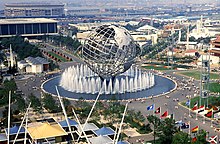|
United States
1964 New York World’s Fair Long Island Rail Road Token
1961 Bronze Medal 28mm (10.53 grams)
1961 NEW YORK WORLD’S FAIR 1964-1965 CORPORATION, Globe in Corona, Queens.
ONE FARE The Route of the DASHING COMMUTER THE LONG ISLAND RAIL ROAD, Commuter running to be on time.
You are bidding on the exact item pictured, provided with a Certificate of Authenticity and Lifetime Guarantee of Authenticity.
 The 1964/1965 New York World’s Fair was a world’s fair that held over 140 pavilions, 110 restaurants, for 80 nations (hosted by 37), 24 US states, and over 45 corporations to build exhibits or attractions at Flushing Meadows–Corona Park in Queens, New York City. The immense fair covered 646 acres (2.61 km2) on half the park, with numerous pools or fountains, and an amusement park with rides near the lake. However, the fair did not receive official support or approval from the Bureau of International Expositions (BIE). The 1964/1965 New York World’s Fair was a world’s fair that held over 140 pavilions, 110 restaurants, for 80 nations (hosted by 37), 24 US states, and over 45 corporations to build exhibits or attractions at Flushing Meadows–Corona Park in Queens, New York City. The immense fair covered 646 acres (2.61 km2) on half the park, with numerous pools or fountains, and an amusement park with rides near the lake. However, the fair did not receive official support or approval from the Bureau of International Expositions (BIE).
Hailing itself as a “universal and international” exposition, the fair’s theme was “Peace Through Understanding”, dedicated to “Man’s Achievement on a Shrinking Globe in an Expanding Universe”. American companies dominated the exposition as exhibitors. The theme was symbolized by a 12-story-high, stainless-steel model of the earth called the Unisphere, built on the foundation of the Perisphere from the 1939 World’s Fair. The fair ran for two six-month seasons, April 22 – October 18, 1964, and April 21 – October 17, 1965. Admission price for adults (13 and older) was $2 in 1964 (equivalent to $16.49 in 2019) but $2.50 (equivalent to $20.28 in 2019) in 1965, and $1 for children (2–12) both years (equivalent to $8.24 in 2019).
The fair is noted as a showcase of mid-20th-century American culture and technology. The nascent Space Age, with its vista of promise, was well represented. More than 51 million people attended the fair, though fewer than the hoped-for 70 million. It remains a touchstone for many American Baby Boomers who visited the optimistic exposition as children, before the turbulent years of the Vietnam War and many cultural changes.
In many ways the fair symbolized a grand consumer show covering many products produced in America at the time for transportation, living, and consumer electronic needs in a way that would never be repeated at future world’s fairs in North America. American manufacturers of pens, chemicals, computers, and automobiles had a major presence. This fair gave many attendees their first interaction with computer equipment. Corporations demonstrated the use of mainframe computers, computer terminals with keyboards and CRT displays, teletype machines, punch cards, and telephone modems in an era when computer equipment was kept in back offices away from the public, decades before the Internet and home computers were at everyone’s disposal.
|




 The 1964/1965 New York World’s Fair was a world’s fair that held over 140 pavilions, 110 restaurants, for 80 nations (hosted by 37), 24 US states, and over 45 corporations to build exhibits or attractions at Flushing Meadows–Corona Park in Queens, New York City. The immense fair covered 646 acres (2.61 km2) on half the park, with numerous pools or fountains, and an amusement park with rides near the lake. However, the fair did not receive official support or approval from the Bureau of International Expositions (BIE).
The 1964/1965 New York World’s Fair was a world’s fair that held over 140 pavilions, 110 restaurants, for 80 nations (hosted by 37), 24 US states, and over 45 corporations to build exhibits or attractions at Flushing Meadows–Corona Park in Queens, New York City. The immense fair covered 646 acres (2.61 km2) on half the park, with numerous pools or fountains, and an amusement park with rides near the lake. However, the fair did not receive official support or approval from the Bureau of International Expositions (BIE).




